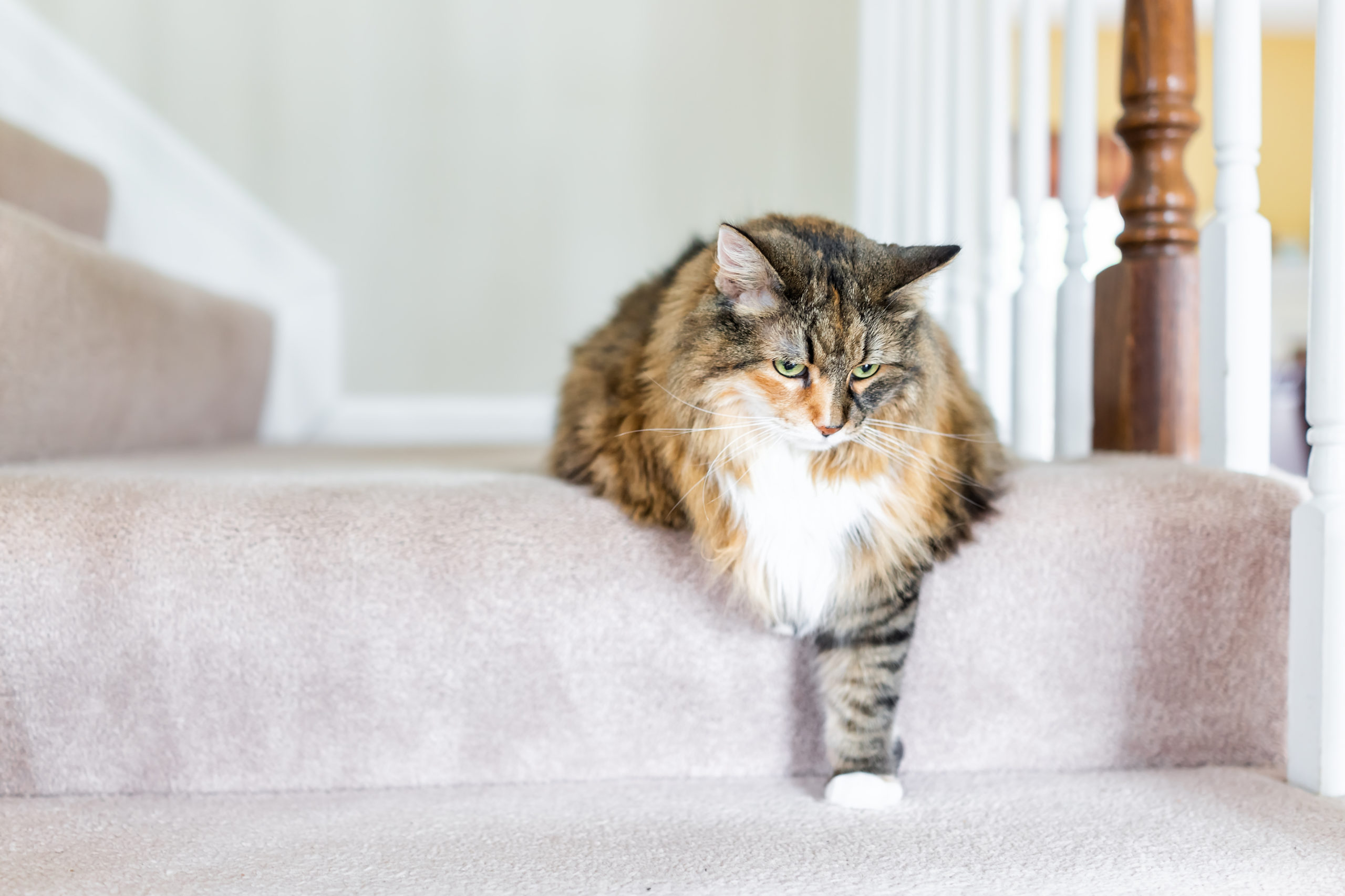Everything you need to know about Arthritis in cats
Arthritis in cats is common, and knowing what to look out for and how to approach treatment means you’re better able to support your feline friend if it strikes. Dr Ellen Marcinkiewicz tells all…
Studies have suggested that 60% of adult cats are affected by Arthritis, and those numbers only increase with age. Arthritis – also known as Osteoarthritis, or OA – is a progressive and painful condition that results in inflammation and degeneration of one or more joints.
What is Arthritis in cats?
Arthritis causes complex changes within the joint, including damage to the cartilage cushion and loss of the synovial fluid that provides lubrication. Over time, this leads to stiff and painful joints with reduced range of motion. The joints most frequently affected by Arthritis in cats tend to be the elbows and hips. That said, Arthritis of the shoulders, hocks and vertebrae (spinal bones) is also common.

What causes Arthritis in cats?
There’s no single cause of Arthritis in cats, but there are multiple factors, including genetics and lifestyle, that may contribute to its development. Overweight cats place significantly more pressure on their joints, leading to accelerated wear and tear. Diseases resulting in the abnormal development of a joint, including Hip Dysplasia, are other contributing factors.
Previous injuries such as broken bones or a ligament tear may also lead to the development of Arthritis in the affected joint. The prevalence of Arthritis in cats is also known to increase with age, with studies showing that more than 90% of cats over 12 years of age have evidence of Arthritis on x-ray.
What are the signs of Arthritis in cats?
Many pet owners are unaware that their cat has Arthritis, because the signs can be quite subtle. Understanding your cat’s normal behaviour and discussing any changes with your veterinarian is key to detecting Arthritis as early as possible.
The signs of Arthritis in cats include:
- Reduced grooming behaviour
- Difficulty squatting when toileting or getting in and out of the litter tray
- Urinating or defecating outside the litter tray
- Lethargy
- Hiding more than usual
- Weight loss (reduced muscle mass)
- Reluctance to jump or reduced jumping height
- Lameness
- Stiffness, especially after rest
- Behavioural changes such as aggression or reduced interaction
If your cat is showing any of these signs, or you have any concerns about their behaviour at home, get in touch with your vet for advice.
How is Arthritis in cats diagnosed?
Your vet will start by taking a history of your cat’s behaviour at home, before performing a thorough physical and orthopaedic examination looking for signs of joint pain, stiffness or thickening.
In some cases, x-rays may be required to make a diagnosis of Arthritis and to rule out other causes of joint disease. Many cats will hide signs of pain due to the stress of the clinic environment. For this reason, your vete may also recommend a treatment trial with pain relief medication to see if you notice an improvement at home.
Treatments for Arthritis in cats
Unfortunately, Arthritis is a degenerative disease that progresses over time. There’s no cure, and treatment is focused on managing pain and slowing down disease progression. Arthritis treatment is considered multi-modal, meaning that there are multiple options and lifestyle adjustments that can be implemented together to try and achieve better results. These include:
Joint supplements
Nutritional supplements containing ingredients such as Glucosamine, Chondroitin, and Omega-3 fatty acids are commonly recommended for Arthritis in cats. These ingredients are believed to have natural anti-inflammatory properties, and can help maintain healthy cartilage and joint fluid.
Joint supplements are safe to use alongside most medications, however, their use should always be discussed with your vet first, as they may not be appropriate for cats with underlying diseases (such as Pancreatitis).
When using joint supplements, remember it can take a few weeks before they take effect. Your vet may recommend using pain relief medication during this time, or in combination with joint supplements long-term.
Medication
There are multiple pain relief medications that can be prescribed to help manage the symptoms of Arthritis in cats. Non-steroidal anti-inflammatories (NSAIDs), like Meloxicam and Robenacoxib, are the most common, but there are multiple options available, including Pentosan Polysulphate injections. As these medications are given long-term, your vet will recommend regular blood tests to reduce the risk of side effects.
Diet and exercise
Overweight cats put significantly more pressure on their sore joints and should be placed on a nutrition plan for weight loss by your veterinarian. The impact of obesity in joint disease is often overlooked, but it’s crucial for improving quality of life.
Gentle exercise also helps to maintain muscle strength and joint mobility. Just take care not to overdo it, as overexertion can lead to painful flare-ups! Try encouraging your cat to exercise using toys, and avoid turning sharply or jumping.

Complementary therapies
Many cats tolerate physiotherapy sessions well, and they can be a valuable addition to the treatment plan to help maintain muscle strength and improve mobility. Alternatives like acupuncture and laser therapy are also reported to help arthritic pets. However, it’s important to understand that the level of qualification and training varies immensely between practitioners. All complementary therapies should be discussed with a qualified vet first, who can then make a suitable recommendation.
Lifestyle modifications
There are lots of ways you can modify your home environment to help a cat with Arthritis feel more comfortable. These include:
- Providing large litter trays with low openings
- Moving feeding stations, water bowls and litter trays to easily accessible locations
- Keeping them warm with heating pads (use only when supervised, under a blanket and on a low-heat setting)
- Elevating food and water bowls so they don’t have to bend so far
- Providing soft, padded bedding
- Providing access to non-slip flooring (such as rugs or carpet)
New technologies
As cat Arthritis research progresses, new treatment options will emerge. Gaining interest in the veterinary field are platelet rich plasma (PRP) and stem cell therapy. Though clinical research is still in the early stages, these options are available at certain specialist clinics. And many practitioners are reporting promising results!
Conclusion
Unfortunately, most cats will be affected by Arthritis within their lifetime and it can be difficult for pet owners to recognise the signs. Monitoring your cat closely for any of the tell-tale behaviours is key for early diagnosis and treatment. Though there is no cure for Arthritis, your vet will be able to develop a comprehensive treatment plan to help relieve pain, slow disease progression, and make your cat as comfortable as possible.




